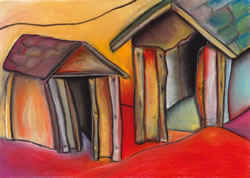| Moab Utah artists. Moab is home to many local artists and nationally known artists. These talented people work in a range of mediums from visual arts through literary to musical. Each month Moab Happenings features one of our talented local Moab artists. Artist of the Month - October 2003 Chad Niehaus: In
the Land of Rapture |
||||||||||
Chad Niehaus, like many artists, has been doing artwork his whole life. He studied for career in graphic design at Colorado State University in Fort Collins, CO, but switched his major to National Resource Management (of which he also did his graduate work) when he became burnt out in graphic design. While in college, Niehaus came to live in Moab seasonally and he continued to nurture his artistic passions through pastel landscape drawing. Niehaus, now a permanent resident of Moab, works for the Bureau of Land Management here in Moab, as a resource manager. Although Resource Management and fine pastel drawing appear unrelated, his professional work and his artwork are truly complimentary.
I originally went to interview Niehaus under the pretense that he did drawings, even though he was primarily a writer. But this is a shallow view of what is really there.
Niehaus makes large-scale soft pastel
images (as well as paintings) of landscapes or images
that evoke memory, emotion and his experience of the land.
His writing officially takes the form a novel called Living
for the Epic published this year. Similar to his imagery,
the novel recounts Ian’s, the main character’s,
adventures of world travel seeking (and finding) ecstatic
and intimate experiences with the land. Nevertheless, I find his imagery both visually and emotionally compelling, while exhibiting a universal appeal in terms of their formal qualities. For example,
Long, one of his most recent
pastel drawings, is immediately emotionally engaging.
Standing at five and a half feet tall and approximately
three feet wide this pastel on raw canvas is overwhelming,
like the land it represents. The vibrant colors and simplified
shapes exemplify the psychical presence of the scene.
The color contrast created between the sky and the rock
formations further heightens the emotional force in this
image. Through the bold use of contour lines and solid
areas of exaggerated color, Niehaus achieves the affect
of abstracting the landscape, while making it his own. The quality of emotion expressed by Niehaus’ abstraction of the landscape in his pastel drawings enticed me into questioning him even further, regarding his intimate
relationship with the landscape. I asked him more or
less point blank whether the experiences recorded in these
drawings were spiritual experiences. I defined for him
spirituality, in my own words, as the self-conscious relationship
to and participation with a force larger than oneself.
He agreed that under this definition his images (and the
adventures recounted in his novel) could be considered
records spiritual experience. Niehaus, however, more aptly
defined the emotional content of his drawings as records
of his experience of rapture, implying full physical,
mental, emotional and spiritual engrossment in an experience.
|




